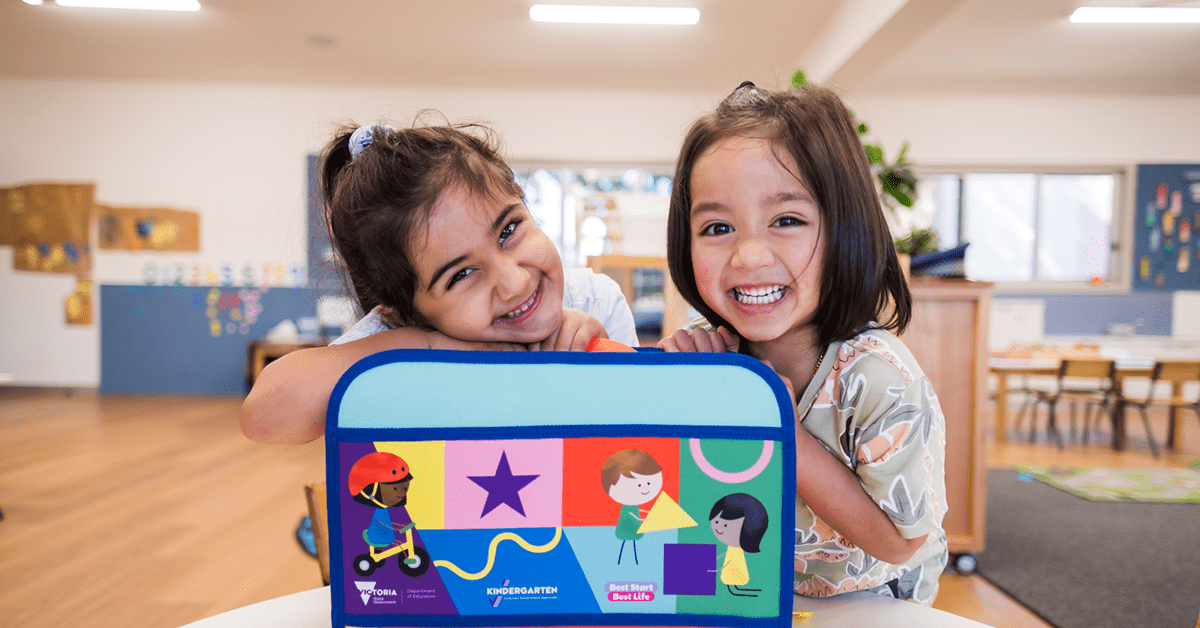What’s a Kinder Kit?
This year, Kinder Kits are packed into a high-quality backpack made with recycled materials. The backpacks have adjustable padded straps and an easy-to-use zip that opens to reveal a felt board on which children can create a story using the provided felt stickers.
All children starting funded Three-Year-Old Kindergarten in 2025 in Victoria are eligible to receive a Kit, including children commencing Early Start Kindergarten and Access to Early Learning programs.
Families don’t need to order a Kit - your kindergarten service will provide the Kits to children in Term 1.
Introducing Kinder Kits
Some items in your Kinder Kit may vary from the items shown in the promotional video.
What’s in the Kinder Kits?
Everything inside the Kinder Kits encourages creativity and open-ended play. The backpack folds out to a felt surface that can be secured with the Velcro tabs and used for imaginative play. Inside the Kit you will find objects and ideas to help you support your child to thrive at the kindergarten, including:
- books by Australian authors
- educational toys and activities by local Victorian designers and businesses
- tips and ideas to help you engage with the Kit and your child’s learning.
Using your Kinder Kit
Everything in your child’s Kinder Kit is designed to be shared and enjoyed as a family. The following items have been designed to help families get the most out of their Kit.
Each Kinder Kit includes a printed Guide for Families, with tips and ideas to help parents and carers guide their child’s early learning and development at home.
The Guide for Families is also available online in 31 languages. To view or download, select your preferred language on the translations page: vic.gov.au/kinder/translations. Translated information explaining what early childhood education is and its benefits is also available.
Meet The Makers
Watch the videos below to learn more about the makers of the Kinder Kit products.
Meet Leanne, from MyCreative Box, maker of the Stackable Animals
Meet Naomi, Co-Founder of Tiger Tribe, maker of the Felt Stories Garden and backpack design
Auslan readings of Kinder Kit books
Each Kinder Kit includes two books from a selection of four, all of which were written by great Australian authors. Watch a reading of the books with Auslan translations.
Heads and Tails Insects by John Canty
Emus Under the Bed by Leann J Edwards
Dream Little One, Dream by Sally Morgan and illustrated by Ambelin Kwaymullina
Kinder Kits are safe and inclusive
Our Kits are child-safe and inclusive of Victoria’s diverse communities.
Each of the items in the Kinder Kits has been recommended by education experts to help families make ‘learning through play’ part of children’s everyday life.
All items in the Kinder Kits meet relevant safety standards and are suitable for three-year-olds.
A small number of items have small parts and are not suitable for use by children under three years of age. These items have been clearly marked with suitable warnings on the outer packaging. They should only be used for their intended purpose. If you have a child under three, please keep these items where they don’t have access to them.
As with all toys for children of all ages, parents and carers should always check before use and discard when there is wear and tear.
The Kinder Kit backpack can be used every day. Leave the Kinder Kit products at home and pack it ready for kindergarten. While the backpack weight meets the Australian safety standard, families are encouraged to monitor the weight of the bag when filled with Kindergarten items to ensure it’s not too heavy.
Why are Kinder Kits important?
The Kits have been designed to celebrate the value of learning through play.
All items in the Kit are carefully chosen to support the following five important learning and development outcomes for children from birth to eight years of age:
- children have a strong sense of identity
- children are connected with and contribute to their world
- children have a strong sense of wellbeing
- children are confident and involved learners
- children are effective communicators.
Updated
